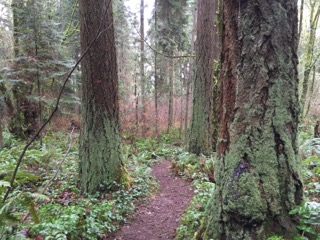It’s a Pacific Northwest morning, and I am enjoying a favorite activity—forest walking and hunting.
As I stroll through salal- and huckleberry-lined trails, my eyes, ever hopeful, scan from side to side, looking for my orange-yellow prey. I inhale deeply the damp, sweet fragrance of the earth. Hours later I return home, triumphant and soaking wet, with a precious bag of chanterelle mushrooms.
The simple daily restorative of walking in nature while breathing clean air belonged to all our ancestors. Today, for many people who live in cities or in countries riddled with poverty and instability, this is a near impossibility. And yet, so many of us with easy accessibility fail to utilize it. This absence exacerbates the toxicity of our current culture.
Forests, Beaches and Deserts
Humans have spent 99.9 percent of their evolutionary history in natural environments. In the last few hundred years we have moved out of our native human habitats—jungles, forests, prairies, and deserts—into our man-made worlds.
A basic Darwinian model postulates that animals evolved in harmony with their habitat. Humans adapted to walking and running long distances in order to procure food. We climbed trees and rocky outcrops for survival. Looking for bugs under rocks and for colorful sea creatures revealed by the receding tide helped us find the protein needed to sustain us. No wonder children have a natural desire to climb trees or scamper up rocks and have a fascination with insects and tide pools.
Most of us no longer live anywhere remotely similar to our natural habitat, and this is having a deleterious effect on our well-being.
Even the passive experience of being in nature excites most of us. Movie producers often incorporate the grand vistas of our natural world. The recent success of the 3-D film Avatar exemplifies our alienation from, and our desire to connect with, nature. Its sights and sounds are harmonic and co-exist peacefully. Hearing bird song, ocean waves, river ripples and the whisper of wind is so relaxing that city and suburban dwellers purchase nature recordings to assist with falling asleep.
Most of us don’t need a scientific study to prove that, visually, the shapes and lines of nature are soothing, or that the rhythmic crashing of ocean waves or leaves crackling in the breeze is nourishing. However, the research does exist.
Studies have shown that when participants view scenes rich in vegetation, areas of the brain associated with emotional stability, empathy and love are more active. These same pathways excite when looking at pictures of loved ones. In contrast, viewing urban scenes produced a significant increase in activity of the amygdala, an area of the brain associated with fear and stress.
The Japanese term Shinrin-yoku translates as “forest bathing” and means taking in the forest atmosphere. Japanese studies show that forest bathing for as little as half an hour dramatically increases signs of relaxation, including lower concentrations of cortisol, lower pulse rate, lower blood pressure, greater parasympathetic nerve activity and lower sympathetic nerve activity than participants doing similar activities in city environments.
In short, there were dramatic benefits from just brief periods of walking and being in a forest. I can only imagine the longer term effects of living daily in natural environments.
Promenade
One of my favorite things on this walk is the multi-toned background music. The intermittent sound of gentle rain contrasts with the sweet celebration of song birds during the dry moments.
On sunnier days I love the crisp sound of leaves crunching underfoot as I follow deer trails. Luckily, one does not need a stealthy gait to hunt mushrooms. When mushroom season ends I am drawn to windy winter walks on the beach and feel calmed by the evening display of the sun setting over the ocean. Not surprisingly, recent research shows that nature scenes can enhance brain-wave activity in ways that are similar to the benefits of meditation.
Studies on walking have shown a plethora of health benefits—increased levels of endorphins, release of toxins, weight loss, mood elevation and even memory enhancement in people with Alzheimer’s disease. However, one of the major benefits, I feel, has been little studied.
Walking is an essential part of information processing; we need to walk for our brains to think correctly. The coordinated left-right body movement of arms and legs swinging forward and back supports both sides of the brain in organizing and assimilating our life experiences. What happens and how we feel about it goes through a sorting process that is facilitated by walking.
This hemispheric dance is enhanced by the scanning of our eyes across a path, as when walking on a trail. This is similar to what happens in REM sleep, when the eyes “scan” back and forth during certain, necessary, stages of sleep.
EMDR (Eye Movement Desensitization Reprocessing) is a therapeutic technique based on this simple idea of alternately stimulating the left and right sides of the brain using visual, auditory or tactile cues. Over the past 20 years, it has proven to be especially helpful in integrating traumatic memory. This advanced technique was originally derived from the founder Francine Shapiro’s personal experience of walking by the waterfront, pondering something distressing. She noticed her eyes automatically scanning back and forth. Later she distilled this into a systematized process for therapeutic use.
Relatedly, some exciting new research (Clearfield) on babies indicates that learning to walk is much more than a developmental motor milestone. The onset of walking catalyzes and supports monumental shifts in perception, attention, memory, cognition and social behavior. Walking and human development are inextricably tied.
Breath of Life
Think about the last time you watched a baby laying on her back, happily breathing, her little belly expanding out and contracting in with each breath.
We instinctively breathe diaphragmatically (belly breathing) unless under stress, when a more shallow, adrenaline-based breathing style kicks in to help fight or flee. The body is designed to return to the deeper “belly” breathing once the stressor disappears and we are safe.
For the majority of westerners, at some point during primary school our bodies forget how to reset to diaphragmatic breathing. Why does this matter? In order to stay healthy, we need our blood to be purified and oxygenated. Consider that approximately a quart of blood flows through the bottom third of our lungs every minute. This blood is being enriched with oxygen to feed our cells while simultaneously exchanging carbon dioxide (to be exhaled out of the body).
Only about a teacup-full of blood flows through the upper third of the lung in the same time period. The difference between that teacup and that quart has a huge impact on the amount of oxygen feeding our cells and the amount of toxins released through exhaling.
Full oxygenation supports our bodies in being slightly alkaline, which research shows is essential to health. Apparently, an acidic environment supports the growth of harmful viruses and bacteria (within the human body and within the world’s oceans). The average human takes 20,000 breaths per day. Imagine the impact on your health of relearning the basic breathing you instinctively knew at birth.
Breathe deep, walk regularly, and enjoy nature. By combining all three you will improve your health, and, if you’re lucky, you might come back with a bag full of gourmet delight to cook up for dinner.
Relephant:
How I Unplugged & Plugged into Nature.
Author: Leslie A. Chertok
Editor: Catherine Monkman
Photo: Robert Ramirez/Flickr, Author’s Own












Read 20 comments and reply